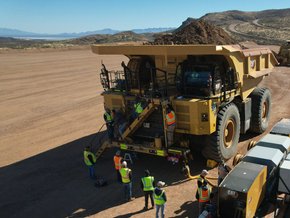Egyptian Minister inspects Tanzania hydroelectric dam

Egypt’s Housing Minister Assem al-Gazzar has carried out an inspection of construction works at the Julius Nyerere hydroelectric dam in Tanzania, which is being developed by an Egyptian consortium of Arab Contractors and Elsewedy Electric at a cost of £2.19 billion.
According to a report by Egypt Independent, Gazzar says that Egyptian President Abdel Fattah al-Sisi is periodically following the project’s progress and explains that his visit is to check up on the project’s implementation.
He adds that the project is a reflection of the relationship between the two African countries, and will help Tanzania progress, providing further electrical power and higher development rates.
Since its inception in December 2018, the project has been carried out smoothly.
Gazzar was accompanied by a Housing Ministry delegation and the Egyptian coalition implementing the project, where he inspects work done at the main dam and the river diversion tunnel, which has been finally finalised.
The project team anticipates that this month will see the river’s course diverted, the report adds.
The power station is located across the Rufiji River in the Stiegler’s Gorge, at the Selous Game Reserve in the Morogoro region, 220 kilometres southwest of Dar es Salaam, the commercial capital and largest city in Tanzania.
The project aims to generate 2,115MW of electricity to provide Tanzania’s energy needs, as well as controlling water levels during flood periods and satisfy the state’s water needs. The 134-dam will have a storage capacity of 34 million cubic meters of water. It will be 100-kilometres long and 1,350 square kilometres in area, while the earth embankment will be 3.7 million cubic metres.
The Egyptian Independent report states that the powerhouse will be above-ground and consist of nine vertical Francis turbines with capacity ranging from 200MW to 300MW each, and power generators with a capacity of 1,200MW each. Power transformers of 235-353MVA each, with a combined capacity of 2,470MVA will be installed. The plant will also include a 400kV switch yard.
Additional infrastructure will include electric switch gears, a protection system and fire detection system, along with an auxiliary power supply, DC systems, cooling and sewage systems.
Furthermore, 10kms of internal roads will be constructed, along with 15kms of residential roads. 350 permanent houses and 3,000 secondary houses.
- Egypt announces US$2.24bn funding for sustainable projectsConstruction Projects
- China-led consortium wins high-speed rail project in EgyptConstruction Projects
- Bombardier named preferred bidder for $2.5bn monorail in EgyptEPC
- Dongfang and Shanghai Electric win Egyptian EPCConstruction Projects






